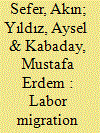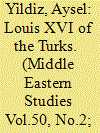| Srl | Item |
| 1 |
ID:
178036


|
|
|
|
|
| Summary/Abstract |
Although mountainous regions remained relatively isolated and almost untouched by the Ottoman rule, labor migration connected the inhabitants of these regions to the socioeconomic and political processes in the Ottoman Empire and beyond. Kruševo, a highland village located in present-day North Macedonia, provides an excellent case for understanding these connections. This paper presents systematic evidence from the Ottoman archives to document and analyze the social, economic, and demographic impacts of labor migration during this period. It provides an in-depth analysis of the Ottoman population and tax records of Kruševo in the 1840s, demonstrating the occupational profiles, migration patterns, and family and neighborhood networks of village residents during this period. Based on this analysis, it argues that labor migration was key to the transformation of social, economic, and demographic relations in rural communities and to the integration of even the most remote highland villages with the modernization processes that characterized the Ottoman Empire in the 19th century.
|
|
|
|
|
|
|
|
|
|
|
|
|
|
|
|
| 2 |
ID:
128222


|
|
|
|
|
| Publication |
2014.
|
| Summary/Abstract |
Selim III ruled the Ottoman Empire in the Age of Revolutions, but his rule did not reflect the vigorous, expansionist and aggressive spirit of this age. He more resembled a ruler forced to defend his empire from the turbulence of the age, an effort which also shaped his character and perception of rulership. During his years in royal confinement, he clung passionately to the revival of the warrior-sultan through charismatic leadership. While on the throne, there was a gradual transformation of his perception of rulership and he became satisfied with being the bureaucratic ruler of the empire.
|
|
|
|
|
|
|
|
|
|
|
|
|
|
|
|